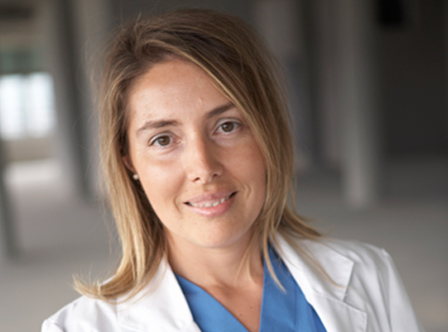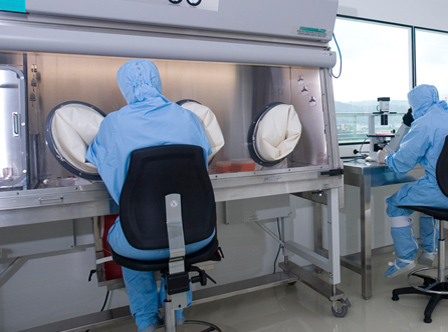INTERVIEW


Begoña Castro is the founder and Chief Scientific Officer of Histocell, a biotechnology company located in the Technology Park of Bizkaia (Basque Country). The company specialises in tissue engineering and cell therapy and now finds itself at the crossroads between these technologies, and is collaborating with IK4-TEKNIKER on some of its projects. Against the backdrop of this interesting experience, she comments on the state of this sector in the Basque Autonomous Community and the directions in which it is heading.
What is tissue engineering? What is Histocell doing in this field?
Tissue engineering is one of the main tools in Regenerative Medicine. The associating of cells with new biomaterials and signalling molecules made possible by this technology means you can develop tissue structures to replace damaged tissues or organs.
Histocell develops tissue engineering and cell therapy technologies to repair and regenerate tissues in the area of osteoarticular damage, cicatrization, nervous systems and pulmonary repair. Most of these developments call for the generation of a biomaterial, the design of which will be determined by the mechanical and metabolic properties of the very tissue that needs to be treated.
At Histocell, either independently or in co-development with a pharmaceutical company, the first clinical phases of the products are reached, either in the area of healthcare products or drugs for Advanced Therapies. This involves production on an industrial level and scaling of the biomaterial, the obtaining of the product in compliance with the standards and regulatory authorizations, so that the clinical phases can start.
What applications does the technology nanoimprinting have in tissue engineering?
Nanoimprinting allows biomaterials to be produced with total control over their internal structure, so that their porosity patterns are distributed homogeneously throughout the biomaterial. This technique is applied to the building of polymer scaffolds in particular, and means that it can only be applied in certain tissue engineering developments.
For the development of new materials by means of nanoimprinting, you need very expensive special equipment and specialised personnel. You can produce tailor-made scaffolds for each patient, but this technology has to be in line with the manufacturing conditions of the standard, in which the maintenance of sterility throughout the process is crucial, and manufacturing costs, which are high in any case, also have to be controlled.
It is an innovative approach of this technique to tissue engineering; tissues that directly nanoimprint cells three-dimensionally for tissue construction are being experimentally developed, without any need to use supporting biomatierials.
What place do micro- and nanotechnologies have in tissue engineering today? What do you think the trend in the future will be?
Nanotechnology applied to tissue engineering is based on the use of biological nanoparticles (proteins, lipids, ATP or DNA) to generate scaffolds, encapsulate cells or develop controlled release systems of a specific factor that somehow intervenes in the regenerative process. This trend is about developing non-toxic structures that reproduce the hierarchical architecture of the extracellular matrix in which the chemical and hardness properties are in tune with those of the tissue you are intending to replace.
Micro- and nanotechnologies have been present in tissue engineering ever since they were born, because all their components are found in the ambit of this scale. Many extracellular proteins have a fibrous structure with diameters within the nanometric and micrometric scale. A range of technologies means you can prepare materials that imitate these cell structures: electrospinning, self-assembly and phase separation. Natural products like collagen, silk fibroin or fibrinogen as well as synthetic materials (PGA, PLLA, PLGA and PCL) have been used to process nano- and micromaterials.
What are the possibilities of R+D centres like IK4-TEKNIKER collaborating with biocompanies like Histocell in this field?
Until now, in the case of Histocell, the collaboration with IK4-TEKNIKER has been based on the great knowledge the centre has in the generation of bioactive surfaces, which can determine the arrangement of cells on a material and even their biological behaviour. IK4-TEKNIKER’s capacity to develop new devices including the control of the components and surface structure is combined with Histocell’s know-how in cellular biology; Histocell conducts research into the changes brought about by these surfaces in various cell types, and this can have a clinical impact in the generating of new products in the biotechnological field.
Right now, Histocell is collaborating with IK4-TEKNIKER in the sphere of a European project to produce an analysis kit, and a new tissue engineering product to regenerate bone and cartilage.
Apart from the research programmes eligible for funding, another new formula for collaboration that is emerging is engaging in co-development to generate a new product. Projects like this involve co-funding of the research between companies like Histocell and the R+D centres. But it also means maintaining co-ownership over the product developed, and so both parties can expect to benefit from the technology licence and the future royalties.
What stage are the development and application of these technologies at in the Basque Autonomous Community? And in Europe?
These technologies are in an experimental phase in both Europe and the Basque Autonomous Community, and this will determine the therapeutic potential of the various developments. However, if the various projects are to lead to commercially viable products, considerable barriers still have to be overcome; these include the production of the processes on an industrial scale, the establishing of the effectiveness of the new developments with respect to the already existing techniques and products, the control of the marketing cost, and compliance with the regulatory requirements in all the phases to generate the product.



